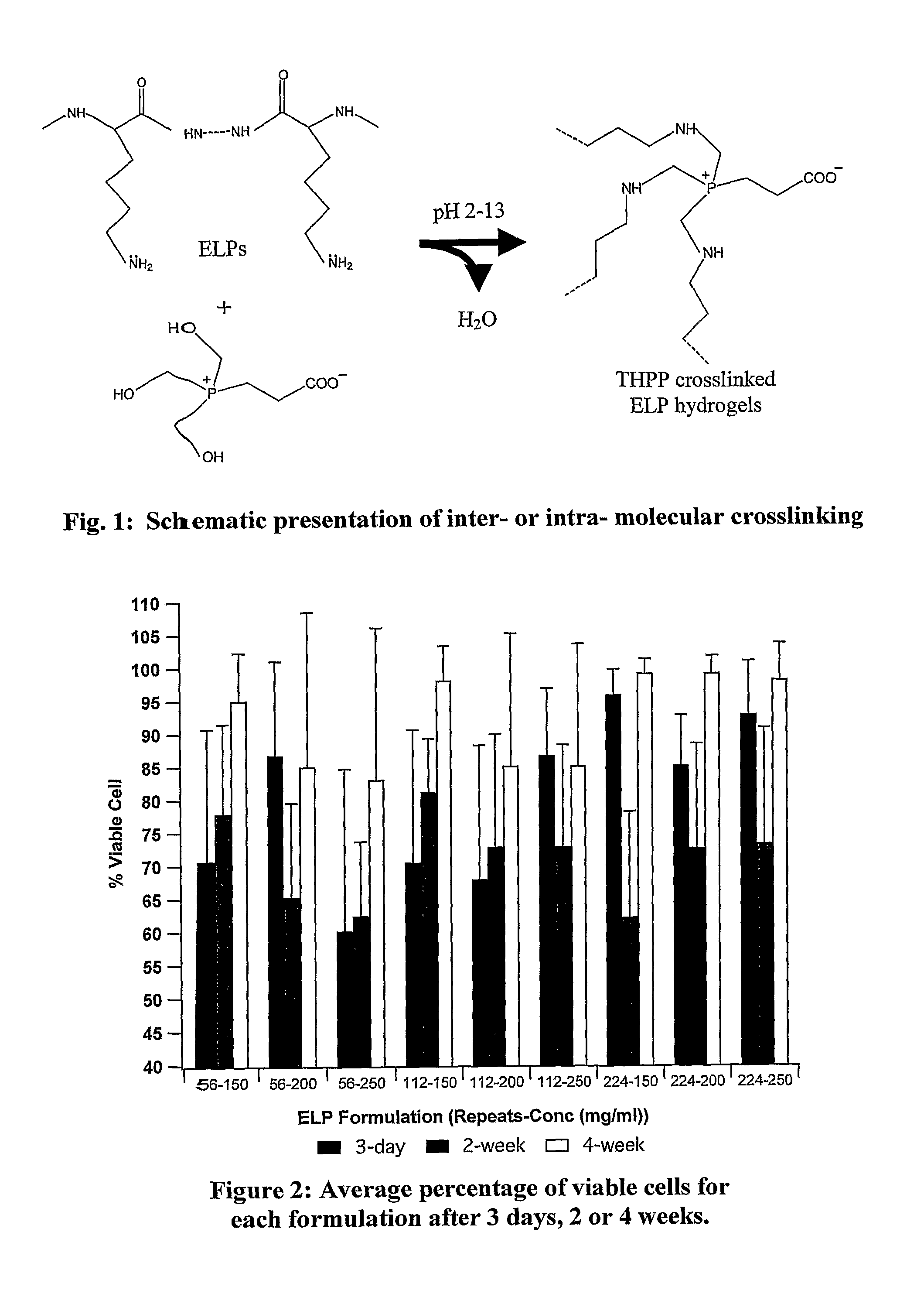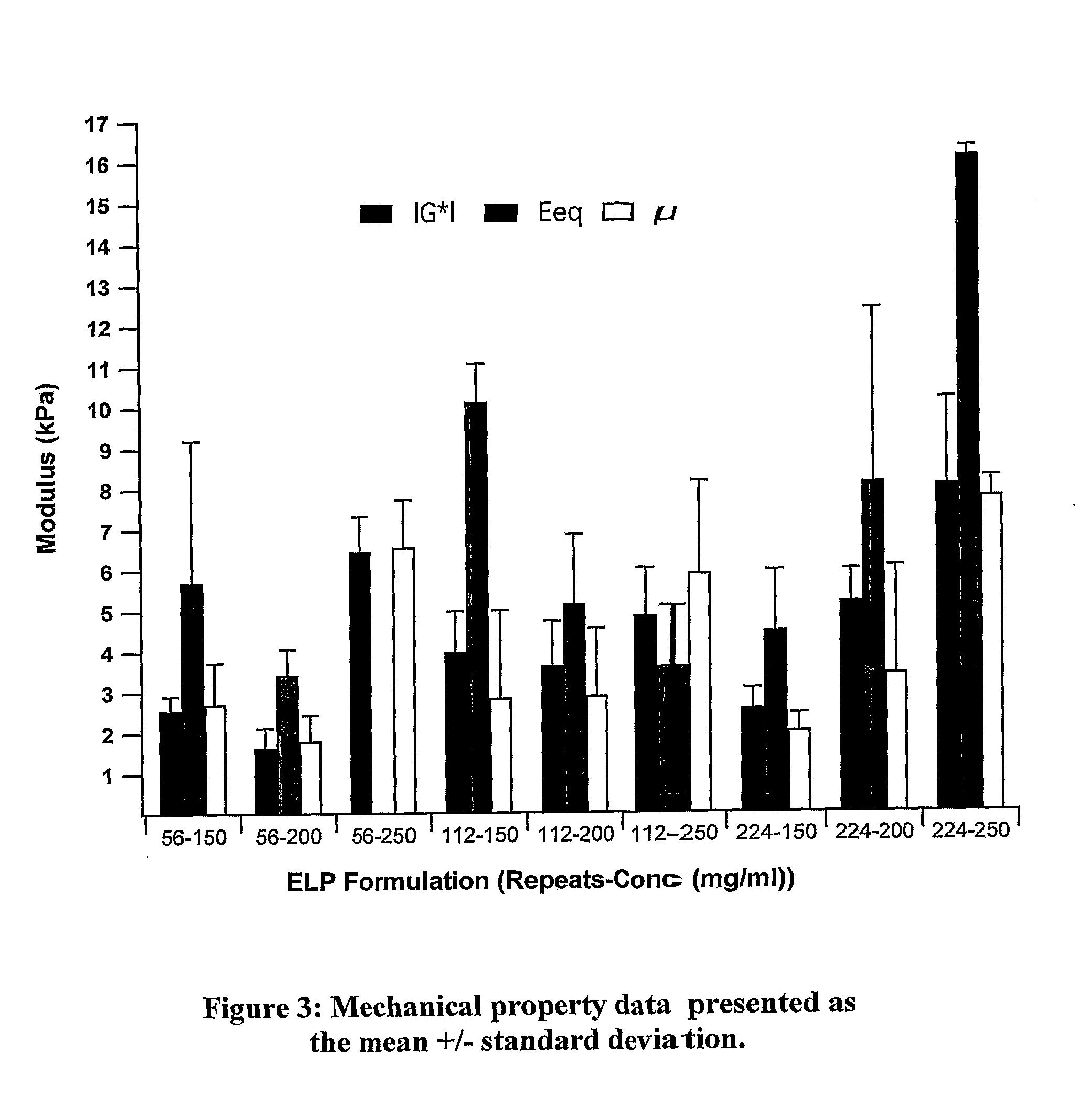In-Situ Crosslinkable Elastin-Like Polypeptides for Defect Filling in Cartilaginous Tissue Repair
a cartilaginous tissue and defect filling technology, applied in the field of in-situ crosslinkable elastin-like polypeptides for cartilaginous tissue repair, can solve the problems of limited self-repair ability, tissue defects and pathological changes may progress to end-stage joint disease, and no biocompatible and non-immunogenic biomaterials have been engineered with physical properties, etc., to achieve higher ph crosslinking solvent, higher frequency of crosslinkabl
- Summary
- Abstract
- Description
- Claims
- Application Information
AI Technical Summary
Benefits of technology
Problems solved by technology
Method used
Image
Examples
example 1
Cell Viability
[0065]Primary porcine chlondrocytes were isolated from the femoral chondyles of skeletally immature pigs. After isolation and washing, cells were concentrated to 100×106 cells per ml in sterile HEPES-buffered saline.
[0066]ELP[KV6-56] (MW=23.9 kDa), ELP[KV6-112]] (MW=47.1 kDa), and ELP[KV6-224] (MW=94.3 kDa) were synthesized using a genetic engineering method, where the monomer of the ELP gene was chemically synthesized and oligomerized using recursive directional ligation (RDL) as described by US Patent Chilkoti. The protein was then expressed in E. coli and purified using the inverse transition cycling (ITC) technique in accordance with known techniques (see, e.g., U.S. Pat. No. 6,699,294 to Urry).
[0067]The purified proteins were then sterile filtered through 0.2 μm syringe filters and their concentrations measured on a UV spectrophotometer. Three aliquots were taken from each molecular weight of ELP and the concentrations adjusted to 150, 200, or 250 mg / ml so that th...
example 2
Mechanical Testing of ELP5'S
[0070]ELP hydrogels were crosslinked with THPP. ELP[KV—6-56] (MW=23.9 kDa), ELP[KV—6-112] (MW=47.1 kDa), and ELP[KV—6-224] (MW=94.3 kDa) were aliquoted according to molecular weight and the concentrations adjusted to 150, 200, or 250 mg / ml so that there were nine different ELP solutions: 3 molecular weights×3 concentrations. Five 200 microliter aliquots of each formulation were prepared in 1.5 ml microfuge tubes. Fifty milligrams of the crosslinker, b-[Tris(hydroxylmethyl)phosphino] propionic acid (betaine) (THPP), was reconstituted in 200 microliters sterile HEPES-buffered saline. The required amount of THPP was then added to one ELP aliquot, so that there was a 6-fold molar excess of hydroxyl groups on the crosslinker to primary amines on the ELP. The crosslinker was dispersed by stirring and pipetting, and the solution was pipetted into custom molds. This was repeated for the remaining four ELP aliquots for a given formulation, one at a time, until all...
example 3
Oscillatory Rheological Test for Crosslinking
[0071]Two new elastin-like polypeptides (ELPs) were designed from Val-Pro-Gly-Xaa-Gly (Xaa: is a guest residue and may be any amino acid other than Pro): ELP[KV7F-72, 144] and ELP[KV2F-64, 128], where the frequency of the guest residue and the number of the repeated pentapeptides are expressed in a bracket. ELPs were genetically synthesized, polymerized in E. coli, and purified by inverse transition cycling (ITC) in accordance with known techniques (see, e.g., U.S. Pat. No. 6,699,294 to Urry). Purified ELPs were dialyzed against water at 4° C. for 3 days to completely remove salt and phosphates, and then freeze-dried for the crosslinking with THPP,β-[tris(hydroxylmethyl) phosphino]-propionic acid in phosphate buffer at pH 7.5 and 12.0. Oscillatory Theological tests were performed when 20 (wt-)% THPP crosslinker in phosphate buffer (pH7.5) at 700 mM of NaCl was added to 20 (wt-)% of ELP [KV7F-144] in phosphate buffer (pH 7.5) prepared onto...
PUM
| Property | Measurement | Unit |
|---|---|---|
| Time | aaaaa | aaaaa |
| Pressure | aaaaa | aaaaa |
| Pressure | aaaaa | aaaaa |
Abstract
Description
Claims
Application Information
 Login to View More
Login to View More - R&D
- Intellectual Property
- Life Sciences
- Materials
- Tech Scout
- Unparalleled Data Quality
- Higher Quality Content
- 60% Fewer Hallucinations
Browse by: Latest US Patents, China's latest patents, Technical Efficacy Thesaurus, Application Domain, Technology Topic, Popular Technical Reports.
© 2025 PatSnap. All rights reserved.Legal|Privacy policy|Modern Slavery Act Transparency Statement|Sitemap|About US| Contact US: help@patsnap.com



